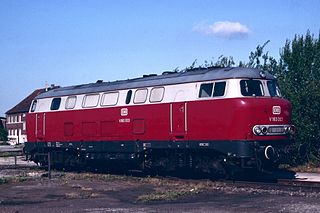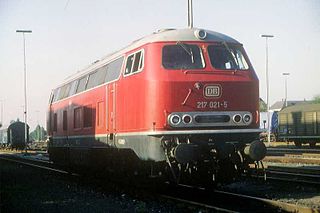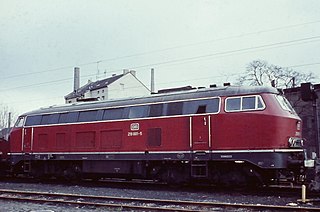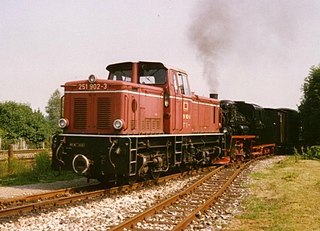
Alstom Traxx is a modular product platform of mainline diesel-electric and electric locomotives produced originally by Bombardier Transportation and later Alstom, which was built in both freight and passenger variants. The first version was a dual-voltage AC locomotive built for German railways from the year 2000. Later types included DC versions, as well as quadruple-voltage machines, able to operate on most European electrification schemes: 1.5/3.0 kV DC and 15/25 kV AC. The family was expanded in 2006 to include diesel-powered versions. Elements common to all variants include steel bodyshells, two bogies with two powered axles each, three-phase asynchronous induction motors, cooling exhausts on the roof edges, and wheel disc brakes.
Originally, both Deutsche Bundesbahn and Deutsche Reichsbahn continued the classification system of the Deutsche Reichsbahn (DRG) – see also a short overview of the numbering system of the German railways. When UIC introduced a new classification system that could be processed by the computers of the late 1960s, DB did a major modification of their system, effective 1 January 1968. This system is still in use and now includes the engines of the former GDR railways as well.

The trainsets of Class VT 11.5 were diesel multiple units built by Deutsche Bundesbahn (DB) in 1957 and used for Trans Europ Express (TEE) services. Perceived as flagships of the DB rolling stock, they carried first-class seating only. When the UIC numbering scheme became effective on 1 January 1968, the power heads of the trainsets were renamed to Class 601 whilst the middle cars became Class 901 according to the DB locomotive classification. They were used for TEE service from 1957 until 1972 and thereafter on German InterCity services.

The DR Class 243 is a universal electric locomotive of the Deutsche Reichsbahn which is used for general rail service. Deutsche Bahn lists the locomotive as Class 143. The locomotives of class 143/243 still belong to the most successful class of German electric locomotives.

The EuroSprinter family of electric locomotives is a modular concept of locomotives for the European market built by Siemens Mobility. The internal Siemens product name is ES 64, with ES for EuroSprinter and the number 64 indicating the 6,400 kW power at rail.

The Class V 160 is a class of diesel-hydraulic locomotives of the German railways. It is the first variant of the V160 family, built for the Deutsche Bundesbahn for medium/heavy trains.

The DB Class V 162 is a class of four-axle diesel hydraulic locomotive built as a development of the DB Class V 160 for the Deutsche Bundesbahn from 1965 to 1968.

The DB Class 215 is a 4 axle diesel locomotive of the V 160 type. They were built for the German Federal Railways for medium-weight passenger and freight service on secondary and primary routes, and later passed to the Deutsche Bahn AG.

The DB Class 218 are a class of 4-axle, diesel-hydraulic locomotives acquired by the Deutsche Bundesbahn for use on main and secondary lines for both passenger and freight trains.

The DB Class V 169 consisted of a single example: V 169 001, derived from the DB Class V 160 family, with an additional gas turbine booster engine. It can be considered the prototype for diesel locomotives with a gas turbine as an additional drive; specifically the DB Class 210. Post 1968 the class designation was changed to Class 219, and the locomotive renumbered 219 001

The DB Class V 60 is a German diesel locomotive operated by the Deutsche Bundesbahn (DB) and later, the Deutsche Bahn AG, which is used particularly for shunting duties, but also for hauling light goods trains. Seventeen locomotives were bought used by the Norwegian State Railways and designated NSB Di 5. Also the Yugoslav Railways bought used units, and designated them JŽ 734; they were subsequently designated Series 2133 by the Croatian Railways.

The Class 210 of the Deutsche Bundesbahn (DB) consisted, briefly, of a series of eight diesel locomotives, with a top speed of 160 km/h intended for operations on express trains. The locomotives were peculiar in that an additional gas turbine engine was able to provide extra power when needed. The additional turbine made it, at the time, the strongest four-axle German diesel locomotive.

The DR 130 family of locomotives comprises the DR Class 130, DR Class 131, DR Class 132 and DR Class 142, in USSR locomotive called TE109 and TE129.

The DBAG Class 225 are a set of related 4 axle diesel hydraulic locomotives from the DB V 160 family. The series does not represent a new build, but a reclassification and/or rebuilding of 1960s and 1970s locomotives of Class 215 and 218 units.

The DB Class V 51 and DB Class V 52 are classes of almost identical narrow gauge 4 axle diesel hydraulic locomotives built in 1964 for the Deutsche Bundesbahn, being built for 750 mm and 1,000 mm gauge lines respectively.

The DBAG Class 145 and DBAG Class 146 are Bo′Bo′ mainline electric locomotives built by Adtranz primarily for the Deutsche Bahn at the end of the 1990s. The Class 145 is the freight version for DB Cargo; the Class 146 is the passenger version for DB Regio. Additional freight machines were built for the former Swiss railway Mittelthurgaubahn as well as for various private operators and leasing companies.

128 001, as registered at Deutsche Bahn, or 12X, as named by its manufacturer AEG Schienenfahrzeuge and its successive owners ADtranz and Bombardier Transportation, is an experimental high-performance electric locomotive built in 1994, which was operated as testbed and test locomotive until 2010. The design of the locomotive featured several technological innovations, including power electronics using new types of semiconductors and water cooling, a new final drive concept, a new bogie concept, and protruding windflaps for improved aerodynamics that gave the locomotive a unique look.

The Teck Railway is a branch line in the German state of Baden-Württemberg, connecting Wendlingen am Neckar with Kirchheim unter Teck and Oberlenningen. In Deutsche Bahn’s timetable it has route number 761. A branch line once ran from Kirchheim to Weilheim an der Teck, but it is now closed.

The DR Class V 100, redesignated the Class 110 in 1970, was a four-axled diesel locomotive for medium duties operated by the Deutsche Reichsbahn of East Germany. Locomotives of the type were also supplied to railways in China and Czechoslovakia and to various industrial operators.
The Gießen–Fulda railway is a single-track main line from Gießen via Alsfeld to Fulda in the German state of Hesse.



















